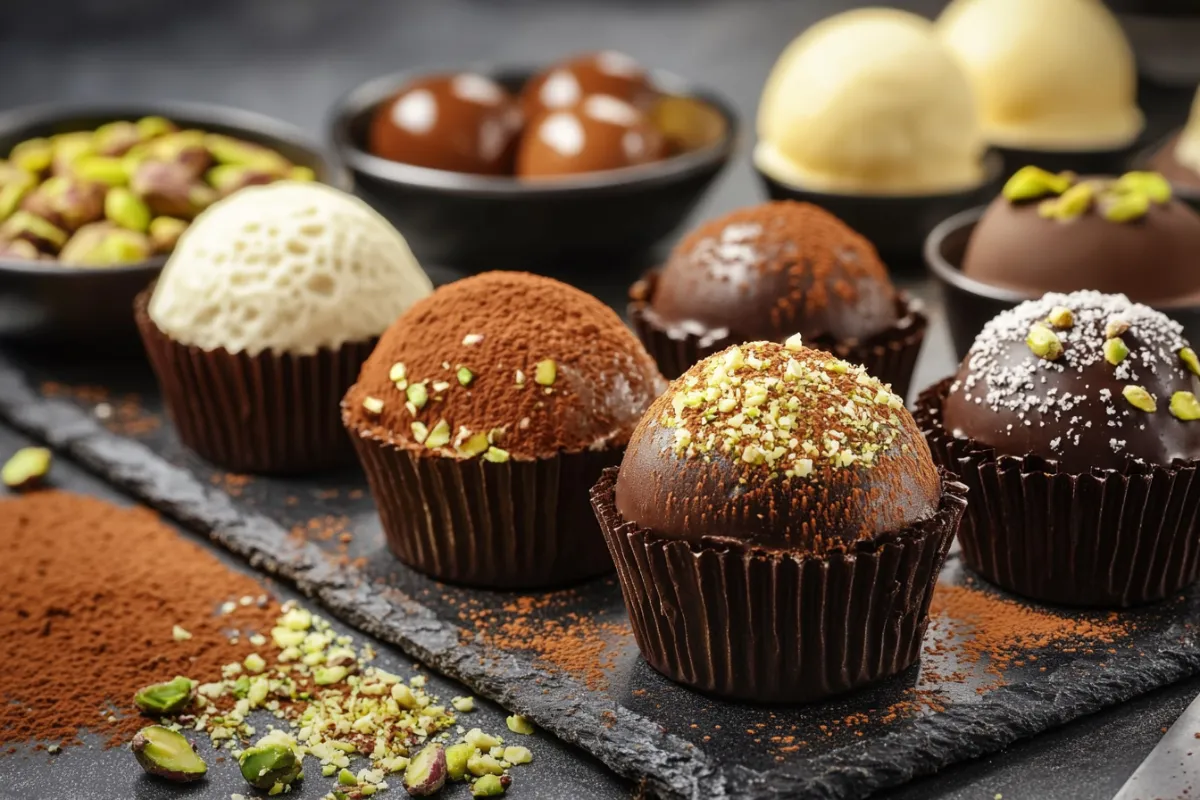Table of Contents
- Introduction: Understanding Italian Frozen Desserts
- What is Gelato?
- Ingredients
- Texture and Flavor
- Serving Style
- What is Tartufo?
- Ingredients
- Structure and Appearance
- Serving Style
- Key Differences Between Gelato and Tartufo
- Ingredients and Preparation
- Texture and Composition
- Presentation and Serving
- Which One Should You Choose?
- Frequently Asked Questions (FAQs)
- Conclusion: Appreciating Both Gelato and Tartufo
Introduction: Understanding Italian Frozen Desserts
Gelato and Tartufo are two popular Italian frozen desserts that have delighted people around the world with their rich flavors and creamy textures. However, they differ in several ways, from their preparation methods to their presentation and overall experience. Gelato is often enjoyed as a simple scoop of smooth, rich ice cream-like dessert, while Tartufo presents itself as a more elaborate treat with multiple layers and textures.
While both desserts originate from Italy and share some similarities in ingredients, they offer distinct flavors and experiences. Gelato is known for its dense, creamy texture and comes in a variety of flavors, making it a versatile option for dessert lovers. On the other hand, Tartufo, which is Italian for “truffle,” is more complex, featuring layers of gelato or ice cream surrounding a hidden filling and encased in a chocolate shell or cocoa powder.
In this article, we’ll explore what sets these two desserts apart, diving into their ingredients, preparation methods, and presentation styles. By understanding these differences, you’ll be able to appreciate each dessert’s unique characteristics and perhaps even choose your favorite!
What is Gelato?
Gelato is Italy’s version of ice cream but with some key differences that make it stand out. It is known for its smooth, creamy texture and intense flavors. While it might look similar to ice cream, gelato has a distinct composition that affects its taste, texture, and overall experience.
Ingredients
Gelato is typically made with:
- Milk (rather than cream)
- Sugar
- Flavorings (such as chocolate, fruit, nuts, coffee, or vanilla)
The lower fat content in gelato, due to its reliance on milk rather than heavy cream, gives it a more concentrated flavor. Additionally, gelato usually contains fewer egg yolks (if any) compared to traditional ice cream. This results in a lighter, yet richer taste.
Texture and Flavor
The churning process used to make gelato is slower than that of traditional ice cream, incorporating less air into the mixture. This slower churn results in a denser, creamier texture. Gelato is also served at a slightly warmer temperature, which helps to highlight its intense flavors and soft texture.
Gelato comes in a wide range of flavors, from classic vanilla and chocolate to fruit-based options like strawberry and lemon. The reduced fat content allows the ingredients’ natural flavors to shine through, making it a delightful treat for all seasons.
Serving Style
Typically, gelato is served in cups or cones, and it is usually scooped using a spatula rather than a traditional ice cream scoop. Its presentation is simple, yet the vibrant colors and enticing aromas make it an appealing choice in gelaterias and dessert shops worldwide.

What is Tartufo?
Tartufo, on the other hand, is an elaborate Italian dessert that combines multiple elements to create a unique treat. Originating from the town of Pizzo in Calabria, Tartufo translates to “truffle” in Italian, inspired by its round, truffle-like shape.
Ingredients
A traditional Tartufo consists of:
- Two flavors of gelato or ice cream (often chocolate and hazelnut)
- A surprise center (usually a maraschino cherry, fruit preserve, or chocolate ganache)
- A chocolate shell or cocoa powder coating
Unlike gelato, which focuses solely on the purity of its flavors, Tartufo combines multiple textures and tastes into one dessert. It is this complexity that makes Tartufo stand out.
Structure and Appearance
Tartufo is not simply a scoop of gelato; instead, it is crafted into a ball or dome shape, often featuring two or more layers of ice cream or gelato. In the middle, there is a hidden filling, such as a maraschino cherry or chocolate syrup, which adds an element of surprise when cut open. The entire creation is then coated in a hard chocolate shell or dusted with cocoa powder.
This outer coating not only gives Tartufo its characteristic truffle-like appearance but also adds a satisfying crunch that contrasts with the creamy interior. The dessert is then frozen to set the layers and coating, ready to be sliced and served.
Serving Style
Tartufo is typically served as a single, indulgent dessert rather than in multiple scoops. It is often presented on a plate, cut in half to reveal its layers and filling. Its elegant presentation makes it a popular choice for special occasions, restaurant desserts, and those seeking a more luxurious ice cream experience.

Key Differences Between Gelato and Tartufo
Although both gelato and Tartufo share similar roots, they differ significantly in their ingredients, preparation, texture, and presentation. Here’s a breakdown of their key differences:
1. Ingredients and Preparation
Gelato: Gelato is made primarily from milk, sugar, and flavorings. It has a lower fat content compared to ice cream because it uses more milk than cream. The mixture is churned slowly, incorporating less air, which results in its dense and creamy texture.
Tartufo: Tartufo incorporates gelato or ice cream but goes beyond with additional ingredients like a surprise filling (maraschino cherry, fruit preserves, or chocolate ganache) and a chocolate shell or cocoa powder coating. Its preparation involves layering and shaping the ice cream into a ball, inserting the filling, and coating it with chocolate, making the process more complex than simply churning gelato.
2. Texture and Composition
Gelato: The texture of gelato is smooth, dense, and creamy due to its lower fat content and slower churning process. It is served slightly warmer than traditional ice cream, which further enhances its soft, velvety texture.
Tartufo: In contrast, Tartufo offers a more varied texture. It combines the creamy smoothness of gelato or ice cream with the crunchy shell of chocolate or cocoa powder on the outside. Inside, the surprise filling provides another layer of texture, whether it be the burst of a cherry, the syrupy richness of chocolate, or the fruitiness of a preserve.
3. Presentation and Serving
Gelato: Gelato is usually scooped into cups or cones, allowing for multiple flavor combinations. It is often topped with garnishes like fruit, nuts, or chocolate chips, but its presentation remains relatively simple.
Tartufo: On the other hand, Tartufo is an all-in-one dessert. It is formed into a ball, coated, and then served as a single entity. Its interior layers and filling are revealed only when it is cut open, making for a dramatic and elegant presentation.
Which One Should You Choose?
When deciding between gelato and Tartufo, it really comes down to the type of dessert experience you’re looking for. Gelato is perfect for those who enjoy a straightforward, creamy treat with intense flavors. Its simplicity allows the natural ingredients to shine, and the variety of flavors makes it a versatile option that can be enjoyed any time.
Tartufo, however, is for those who crave a more elaborate dessert. With its layers, hidden filling, and crunchy shell, Tartufo offers a multi-sensory experience that elevates it beyond a regular scoop of ice cream. It is ideal for special occasions or when you want to indulge in a dessert that combines different textures and flavors in every bite.
Ultimately, there’s no right or wrong choice. Both gelato and Tartufo have their unique charm and are worth trying for any dessert lover.

Frequently Asked Questions (FAQs)
Is Tartufo a type of gelato?
Not exactly. While Tartufo contains gelato or ice cream as its main component, it is more complex due to its layered structure, hidden filling, and coating. Tartufo is a crafted dessert, whereas gelato is simply scooped and served.
Can you use gelato to make Tartufo?
Yes, gelato is often used to make Tartufo. The creamy texture of gelato works well for forming the layers and encasing the surprise center. However, some recipes use regular ice cream as well.
How is gelato different from ice cream?
Gelato differs from traditional ice cream in several ways. It is made with more milk and less cream, resulting in a lower fat content. Gelato is also churned more slowly, which incorporates less air and gives it a denser texture.
Which dessert is healthier: gelato or Tartufo?
Gelato typically has fewer calories and less fat than Tartufo, mainly due to its lower cream content and lack of additional fillings or coatings. Tartufo’s rich center and chocolate shell add extra calories and sugar, making it a more indulgent option.
Conclusion: Appreciating Both Gelato and Tartufo
Gelato and Tartufo are both iconic Italian desserts, each offering a unique take on frozen treats. While gelato emphasizes simplicity, smooth texture, and intense flavor, Tartufo is all about complexity, combining multiple layers, textures, and surprise elements.
Whether you’re in the mood for a straightforward cup of creamy gelato or want to indulge in the layered delight of Tartufo, both desserts promise a delicious experience. By understanding their differences, you can better appreciate the craftsmanship behind these Italian classics and choose the one that best suits your cravings.

